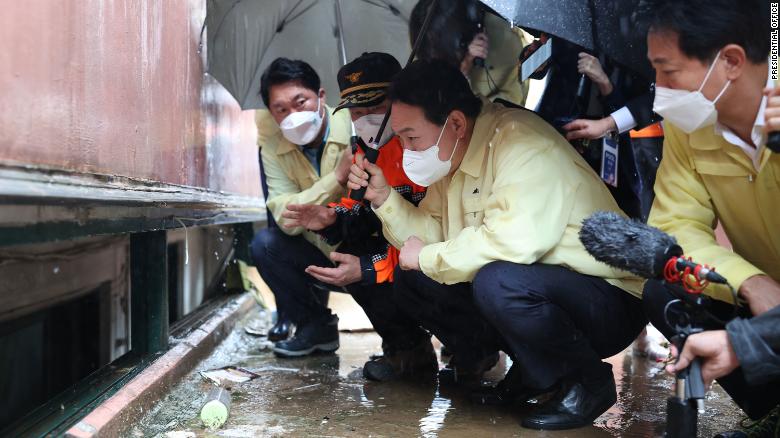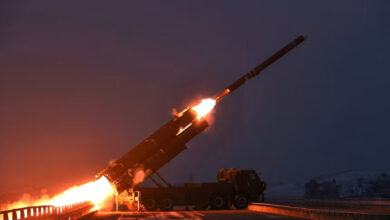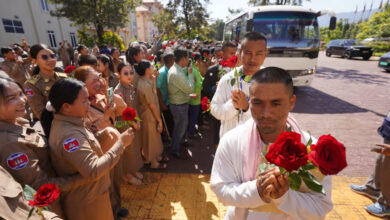
Seoul, South Korea (CNN)Seoul has vowed to move some of the city’s poorest families out of underground and semi-subterranean homes after 13 people were killed in flooding caused by record rainfall this week, sparking public horror and calls for government accountability.
The deaths, which included a family who drowned after becoming trapped underground, have spurred the South Korean capital to put an end to people living in “banjiha” homes — the often cramped and dingy basement apartments made famous by the movie “Parasite.”
The family of three — a woman in her 40s with Down syndrome, her sister, and the sister’s 13-year-old daughter — died after water pressure prevented them from opening the door of their flooded home in Seoul’s southern Gwanak district.
On Monday night, torrential rain — the city’s heaviest in more than 100 years — caused severe flooding in many low-lying neighborhoods south of the Han River, sweeping cars away and forcing hundreds to evacuate.
The family lived in a banjiha — a half-underground apartment, typically several steps below street level. In Seoul’s notoriously expensive housing market, these apartments are some of the most affordable options available — meaning they’re mostly inhabited by young people and those on low incomes.
Often small, dark and prone to mold during the humid summer, banjihas gained global notoriety following the release of Bong Joon-ho’s Oscar-winning 2019 movie “Parasite,” which followed a fictional family’s desperate attempt to escape poverty. The homes have since come to represent rampant inequality in one of the world’s wealthiest cities.
For years, there have been growing calls for the government to provide more affordable housing, improve living conditions in banjihas, or phase them out altogether — which officials pledged to do following public outcry over President Yoon Suk Yeol’s handling of the crisis.
“In the future, in Seoul, basements and semi-basements (banjihas) will not be allowed to be used for residential purposes,” the Seoul city government said in a statement on Wednesday.
However, experts say the government’s promise overlooks larger problems that persist beyond the basement walls, of skyrocketing living costs that force the most vulnerable people to seek shelter in substandard housing susceptible to floods and heat — some of the worst effects of climate change.
Bunkers to boom
Banjihas were first built in the 1970s to serve as bunkers amid rising tensions with North Korea, said Choi Eun-yeong, executive director of the Korea Center for City and Environment Research.
As Seoul modernized in the following decade, attracting migrants from rural regions, diminishing space prompted the government to allow residential use of the basements — even though they were “not built for residential purposes, but for air raid shelters, boiler rooms or warehouses,” said Choi.
Banjihas have long been riddled with problems such as poor ventilation and drainage, water leakage, lack of easy escape routes, insect infestation, and exposure to bacteria. But their low price is a major draw as Seoul becomes more unaffordable — especially for young people who face stagnating wages, rising rents and a saturated job market.
The average price of an apartment in Seoul has more than doubled in the past five years, reaching 1.26 billion won ($963,000) in January this year — making it less affordable relative to income than New York, Tokyo and Singapore.
The safety concerns regarding banjihas were thrust to the fore when severe flooding in 2010 and 2011 left dozens dead.
In 2012, the government implemented new laws prohibiting banjiha apartments in “habitually flooded areas.”
But the attempt at reform fell short, with 40,000 additional banjihas built after the law passed, according to a news release by city authorities.
Officials again vowed to investigate the issue after “Parasite” shone a spotlight on banjihas — but they were soon sidetracked by the Covid-19 pandemic, Choi said.
As of 2020, more than 200,000 banjiha apartments remained in downtown Seoul — making up about 5% of all households, according to the National Statistical Office.
Along with its failure to improve housing, the city government came under fire this year after slashing its annual budget for flood control and water resources management by more than 15% to 17.6 billion won ($13.5 million).
Family drowned
The family who died in Gwanak couldn’t escape their apartment due to water building up outside their door, said Choi Tae-young, head of the Seoul Metropolitan Fire and Disaster Headquarters.
The fire and rescue chief accompanied President Yoon to the site of the deaths on Tuesday, where they inspected the building and interviewed some of its residents. Photos show the president squatting on the street, peering through the ground-level window into the still-flooded basement apartment.
“I don’t know why the people here didn’t evacuate in advance,” Yoon said during the inspection — a remark that has since been widely criticized online.
“Water came in in an instant,” one resident replied.
“It took less than 10 or 15 minutes (for the water to rise),” another resident said, adding that the victims “lived very, very difficult lives.”
In its statement Wednesday, the Seoul city government said it would phase out basement and banjiha apartments “so they cannot be inhabited by people, regardless of habitual flooding or flood-prone areas.”
Banjihas are “a backward housing type that threatens the housing-vulnerable in all aspects, including safety and residential environment, and should now be eliminated,” said Seoul Mayor Oh Se-hoon.
The elimination process will include a “grace period” of 10 to 20 years for existing banjihas with building permits, and tenants will be helped to move into public rental housing, or receive housing vouchers, the government said in a statement. After banjihas have been cleared, they will be converted for non-residential use, it added.
Choi Eun-yeong, the urban environment researcher, expressed skepticism over the government’s purported commitment to eliminating banjihas, arguing the proposal was overly ambitious and lacked concrete details such as specifics on the timeline or compensation figures.
“In fact, I think there is a very high possibility that it will only be a declaration and not be implemented,” she said, pointing to the government’s various promises — and limited success — over the years.
Poorest hit hardest
The rain has now eased in Seoul — but experts warn that this kind of extreme, unpredictable weather will become only more frequent and intense due to climate change.
The climate crisis is “raising the temperature of the Earth and the ocean, which means the amount of water vapor the air can hold is getting bigger,” said Park Jung-min, deputy director of the Korea Meteorological Administration press office. “It’s up to the weather, where this bag of water will pour.”
As is often the case, it seems likely the poorest will be among those hit hardest.
“Those who have difficulty with living and those who are physically ill are bound to be more vulnerable to natural disasters,” President Yoon said on Wednesday. “Only when they are safe, is the Republic of Korea safe.”
Similar problems have occurred in other countries in recent years; in parts of India, monsoon floods have repeatedly destroyed slums; in Bangladesh, many people have migrated from villages to urban areas to escape increasingly frequent floods.
And in the United States, research has found that Black, Latino and low-income families are more likely to live in flood-prone areas.
Apart from chronic displacement and disrupted livelihoods, the expected increase in rain across Asia could bring a host of health hazards including higher risk of diarrheal diseases, dengue fever and malaria — a further blow to already impoverished families without access to medical care or the means to relocate.
Meanwhile, flooding and drought could cause rural poverty and rising food costs, according to the United Nations’ Intergovernmental Panel on Climate Change.
In Seoul, banjiha residents face the double danger of flooding and heat waves, Choi Eun-yeong said.
“The changes brought about by the climate crisis are almost catastrophic, especially for the most vulnerable, because they don’t have proper housing to respond to those conditions,” she said.




